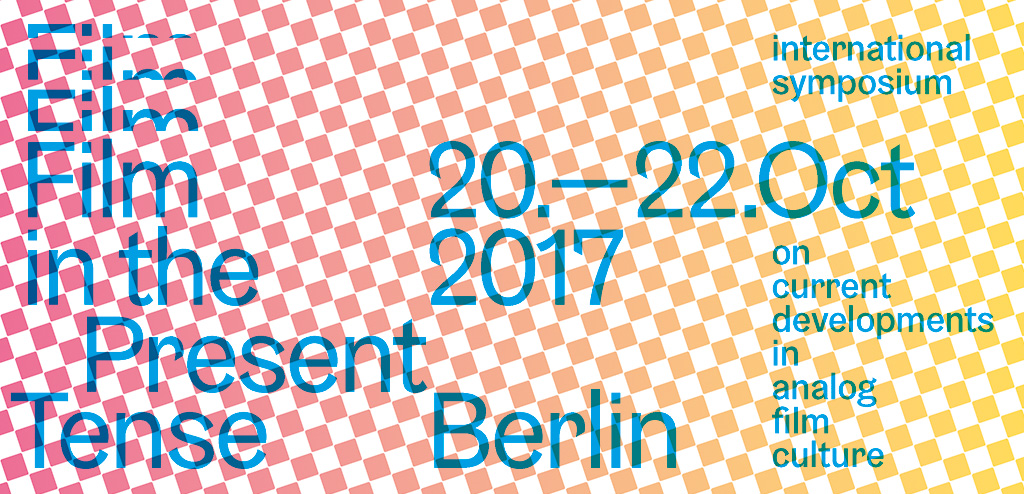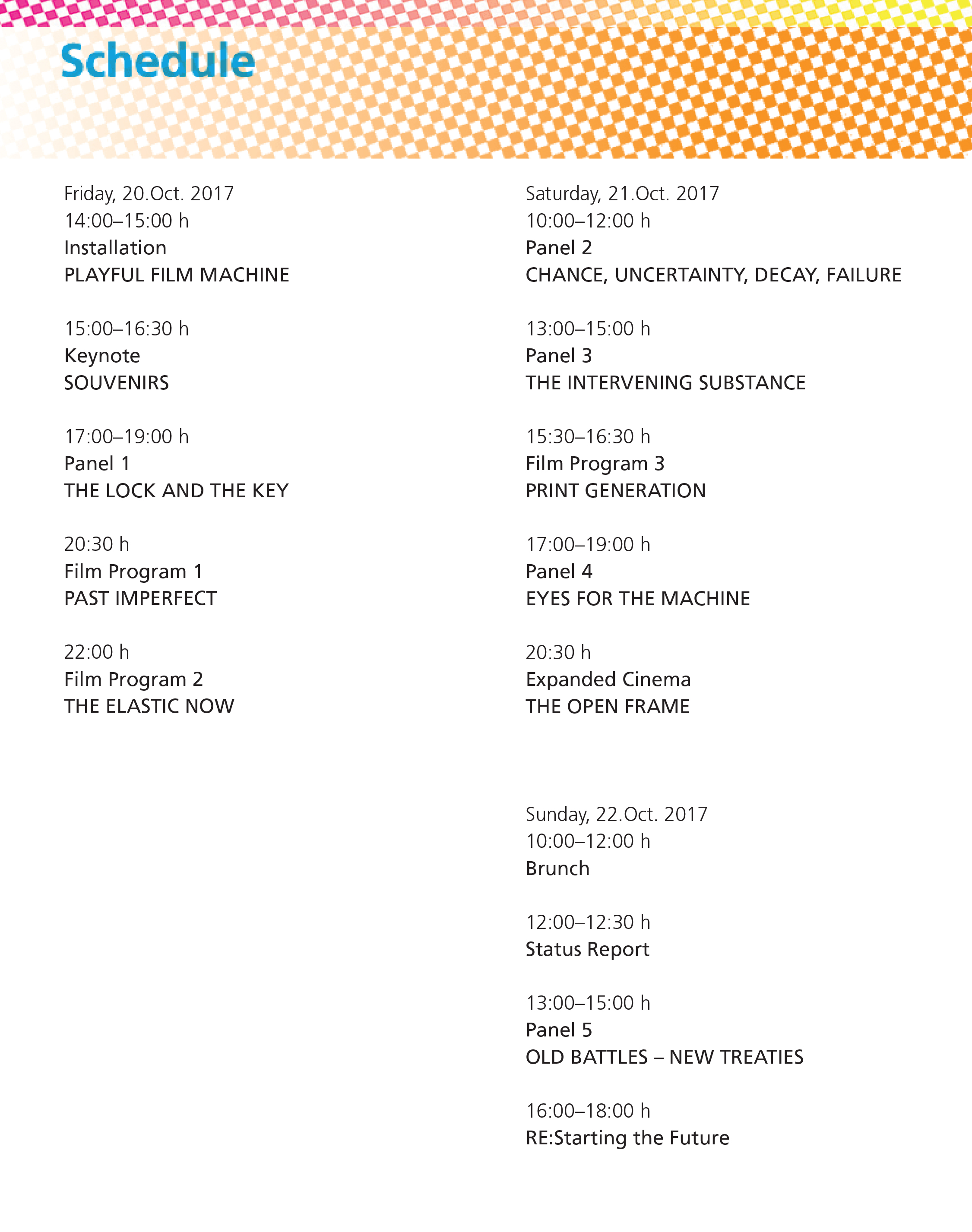
In spite of claims of its obsolescence, analog film is still alive. It continues to exist as an inimitable artistic medium, put to use in myriad forms around the world. Nonetheless, in the context of our ever-expanding digital landscape, analog film faces new challenges that have forced it into a process of deep transformation. What steps do we need to take to guarantee that analog film will remain as a living-breathing medium? What are the alternatives to the idea of film as an obsolete, historical object? What new forms will film take and what will that mean for the culture that surrounds it? How do we keep analog film in the Now?
Organised by LaborBerlin in cooperation with the Film Institute of the Berlin University of the Arts, Film in the Present Tense will bring together filmmakers, artists, programmers, technicians and representatives from museums, independent film labs and cinemas to address these questions and formulate ideas, possibilities and plans of action for keeping film current and alive. In addition to six panel discussions, there will be screenings and expanded cinema performances presenting some of the ways in which film continues to exist “in the present tense”.

Keynote
SOUVENIRS by Mark Toscano
In English, a “souvenir” generally refers to an object that has some personal, referential, perhaps symbolic meaning. This meaning is usually linked to an experience, a place, a person, a time. A souvenir is basically an object connected to a memory. But in its original French, a souvenir can refer not only to this object, but also to the memory itself.
Film is possibly the ultimate souvenir, in the French sense, representing a memory, a memory-object, and the complex interaction between the two, spanning past, future, and present. This illustrated talk will seek to explore these dual, yet intertwined natures of the medium, as well as whether film itself may provide compelling evidence that there’s no such thing as a present tense.
Panel 1
THE LOCK AND THE KEY
What is the purpose of the film archive? And perhaps even more importantly, who is it for? All over the world, the transformations within the film industry have forced film archives to reassess their roles. On the surface, the public discussion has focused on digital vs. analog with the advantages and disadvantages that each one entails. Bearing this in mind, with this panel we want to push beyond this discussion and look at the practical reality of numerous archives around the world. They have enormous collections of film and it is unclear what the future existence of this material will look like. Will it be left to decay in vaults and inadequate storage rooms or will it be a living, open resource to the public? What does an open, public archive look like? Can the archive be used to build a film audience? What place does the personal, the independent and the non-government archive occupy?
Panelists:
Dr. Anna Bohn (Filmothek der Zentral- und Landesbibliothek Berlin, Germany)
Tiago Ganhão (Cinemateca Portuguesa, Portugal)
Juana Suarez (New York University, US)
Moderation:
Mark Toscano (Academy of Motion Picture Arts and Sciences, US)
PANEL 2
CHANCE, UNCERTAINTY, DECAY, FAILURE
It should not come as a surprise to anyone to hear that the knowledge of motion picture filmmaking is rapidly disappearing. However, until very recently the type of knowledge that was being put into practice was quite particular: one that functioned according to the technical demands and standards of the film industry.
The ontological nature of motion picture film prescribes another type of knowledge that at this present time has surged to the foreground and cannot be replicated by the digital; not only due to the mechanical properties of the medium, but also because of the philosophical underpinnings of the analog workflow. Choosing to work with analog film today, means having to reckon with the inherent qualities of the medium, which is to say, having to deal with – among others – chance, uncertainty, decay, failure, the non-standard and the impermanent. In our present time, adopting film as a medium implies the ability to create a very particular relationship with these qualities. What is the state of this knowledge right now? And where does its transfer take place? Is it in the independent lab, the university, the archive, the museum? How and in what form can the knowledge of motion picture film continue?
Panelists:
Nick Brandreth (George Eastman Museum, US)
Nicolas Rey (L’Abominable, France)
Philip Hoffman (Film Farm, Canada)
Moderation:
Stefanie Schulte Strathaus (Arsenal – Institute for Film and Video Art, Germany)
PANEL 3
THE INTERVENING SUBSTANCE
Film is a physical medium. As a perforated stripe coated with light sensitive emulsion it has a material existence. Although “film” is now used as conceptual support for various cinematographic events, its substance has been defined by its physical qualities as a carrier of moving images.
Since the material of film is no longer demanded at the massive industrial scales of the recent past, the numbers of film stock manufacturers and the variety of raw film formats have declined. Analog film has changed from a cheap mass product to a limited resource, to the point that rare types are hoarded and production strategies, which were once commonplace, are now impossible. At the same time, old emulsion recipes are being resurrected and entire production plants are being reactivated. Artists are producing their own film emulsions and experimenting with the basic ingredients of film at the artisanal level. In the face of these developments, how should we consider the materiality of film? Can analog film exist if its industrial production ceases completely? How does the relationship of artists to the concept of “analog” shape the way in which film moves forward as an artistic medium?
Panelists:
Nicola Baldini (FILM Ferrania, Italy)
Esther Urlus (Filmwerkplaats, Netherlands)
Emmanuel Lefrant (Light Cone, France)
Moderation:
Martin Reinhart (Filmmaker, Austria)
Panel 4
EYES FOR THE MACHINE
For over a century, the ritual of film exhibition remained at its core unchanged: a dark room, a screen, an audience and a mechanical apparatus pulling a strip of film through a gate in front of a shuttered light. At present, however, the mechanical film apparatus is no longer at the center of the cinematic experience. While some seek to maintain its role within the cinema, the film projector has acquired new prominence in different settings: the museum, the gallery, the art space, and the music venue, among others. Although the experience of analog film projection continues to exist, these new locations suggest a transformation of its value and meaning. For both, artists and their audiences, the analog as a place of encounter continues to be redefined. Is there a sustainable future for analog projection? Which conditions are needed, and which projection sites are suited for its lasting subsistence? What kind of structures must be created to foment a knowledgeable and supportive audience?
Panelists:
Dr. Erika Balsom (King’s College, UK)
Katia Rossini (Cinema Nova, Belgium / Kino Climates)
Christopher Mondt (Filmprojektion Mondt, Germany)
Moderation:
Shai Heredia (Experimenta India / Srishti Institute of Art Design & Technology, India)
PANEL 5
OLD BATTLES – NEW TREATIES
It was the existential question par excellence: analog or digital? Which format is more beautiful, faster, better? Until very recently, it seemed like the dispute had been settled with the digital emerging victorious.
The verdict went like this: in the short term, for the nostalgic, the qualities of analog film should be regarded as aesthetic ornaments which could easily be emulated by digital means. Eventually, the imminent arrival of a new generation of filmmakers, themselves digital natives, would finally make the digital supreme and the preeminence of analog film could be regarded as no more than a historical anecdote. But what if this means jumping to conclusions? What if this situation presents conditions for the beginning of a new cooperation? With analog film no longer subject to the requirements of the industry, is it possible to see a new space for the creative co-habitation of the digital and the analog? What form could this relationship take? Is there a possible analog-digital hybrid state and what could it mean for the production and distribution of moving images?
Panelists:
Olga Moskatova (Bauhaus Universität Weimar, Germany)
Prof. Dr. Christa Blümlinger (Université Paris 8, France)
Guy Edmonds (University of Plymouth, UK)
Moderation:
Dr. Kim Knowles (Aberystwyth University, UK)
>> Berlin University of the Arts [Grunewaldstraße 2, 10823 Berlin]
FILM PROGRAM 1
PAST IMPERFECT
Memory is extraordinarily imperfect and subjective, functioning as a prismatic, personalized response/record of experience, augmented by innumerable other external and internal factors. Film is quite similar, bearing witness to and being uniquely and unrepeatably marked by experience even before the filmmaker begins to create something from its material. The end result – a film – is a holistic articulation of these numerous, intertwining qualities of experience, memory, presence, awareness, intentionality, chance, and the unknown. Personal film records, such as home movies, carry rich layers of meaning and poignancy, even when they’re not images from our own lives. I’m convinced this has something to do with the intimate materiality of the medium – not only because of our awareness of film as a tangible object, but also because like a body and a consciousness, it is capable of experiencing something, physically capturing some aspect of it, and replaying it back with a strange and endlessly variable relatability.
This program brings together a series of films which speak to these deeper notions of film as a participant in memory and subjective experience. They are also all films about people: family, friends, and communities of significance to the artists, who used the medium of film in various ways to relate their feelings, thoughts, and memories about those people to a roomful of receptive strangers.
Curated by: Mark Toscano
Films by: Bruce Baillie, Tacita Dean, Roberta Friedman & Grahame Weinbren, Barbara Hammer, James Otis, John Price, Chick Strand
>> Arsenal – Institute for Film and Video Art [Potsdamer Straße 2, 10785 Berlin]
FILM PROGRAM 2
THE ELASTIC NOW
The Elastic Now is a programme daring us to be of and in the present. Probing interrelated temporalities – individual and collective, technological and societal – these are films that have inscribed themselves in our recent memory. They reside in an “elastic now“, one that we carry with us to the cinema, formed by multiple strata of connections to both ends of the present – the past and the future. The films of this programme are indebted to ethnographic and essayistic documentary filmmaking, to structural film, to found footage appropriation, to Super 8 post-punk playfulness, and bold explorations of narrative. A common current is a pleasure in their respective analogue shooting formats’ means to negotiate a sense of presence and immediacy. Together they offer a glimpse into the work of artists and filmmakers engaged in an analogue film practice which is as varied and vital as ever.
Curated by: Peter Taylor, Philip Widmann, Ulrich Ziemons
Films by: Anouk De Clercq, Shumona Goel & Shai Heredia, Elke Marhöfer & Mikhail Lylov, Camilo Restrepo, Miko Revereza, Fern Silva
>> Arsenal – Institute for Film and Video Art [Potsdamer Straße 2, 10785 Berlin]
EXPANDED CINEMA
THE OPEN FRAME
The basic elements of projection – frame, screen, theater – have always been constructs, historically at the mercy of subjective propriety and commercial interests. For decades, the live manipulation of analog projection has provided artists with an opportunity to push beyond the physical limits of the traditional frame and the commercial screen. In this program, we present works that transform sound, image and space to create unrestrained, exuberant and wide-open cinematic events.
Curated by: Anja Dornieden, Juan David González Monroy, Julian Ross
Works by: Britt Al-Busultan, Sally Golding, Scott Fitzpatrick, Guy Sherwin, Zeropixel
>> Circular Economy House [Rollbergstr. 26, 12053 Berlin]
Tickets are now available here!
Film in the Present Tense is the closing event of RE MI.
RE MI is a two-year European cooperation project run by Mire (Nantes, FR), WORM.Filmwerkplaats (Rotterdam, NL) and LaborBerlin (Berlin, DE), focused on the creation, preservation and circulation of technical knowledge of analogue film in order to support its use as a creative medium.
Congress language is English.
Download our Presskit in English or German:
Funded by:

